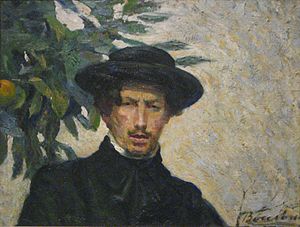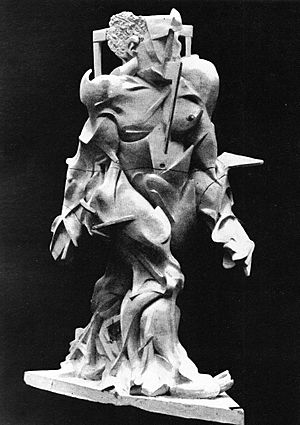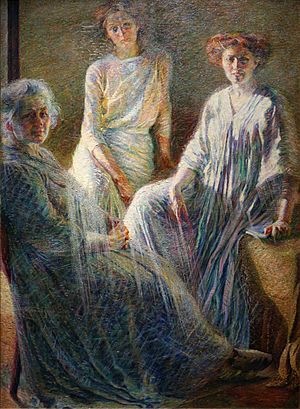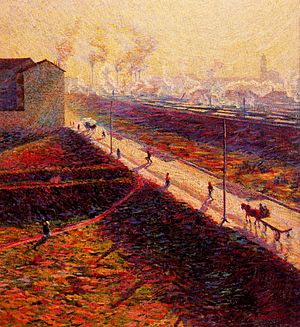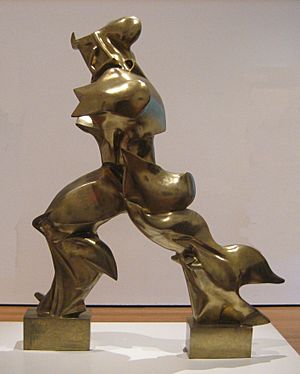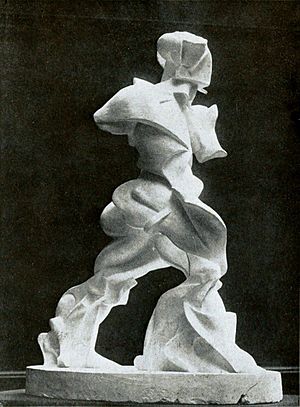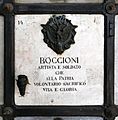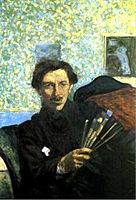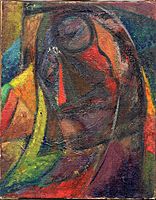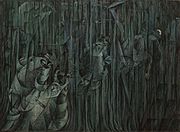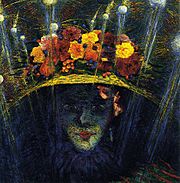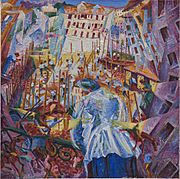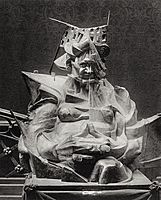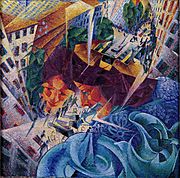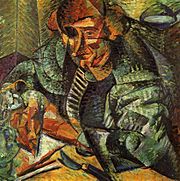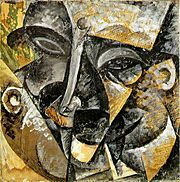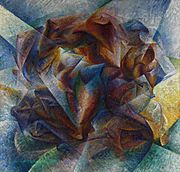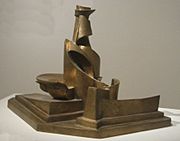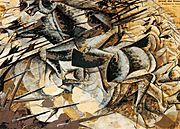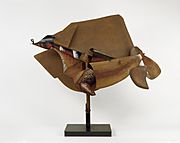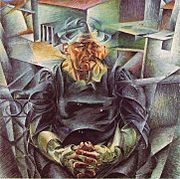Umberto Boccioni facts for kids
Quick facts for kids
Umberto Boccioni
|
|
|---|---|
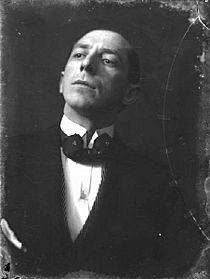
Umberto Boccioni
|
|
| Born | 19 October 1882 Reggio Calabria, Italy
|
| Died | 17 August 1916 (aged 33) Verona, Italy
|
| Nationality | Italian |
| Education | Accademia di Belle Arti di Roma |
|
Notable work
|
Unique Forms of Continuity in Space The City Rises The Street Enters the House |
| Movement | Futurism |
Umberto Boccioni (born October 19, 1882 – died August 17, 1916) was an important Italian artist. He was a key figure in the exciting Futurism art movement. Even though he lived a short life, his ideas about movement and breaking down shapes influenced many artists. His art is shown in museums around the world. In 1988, the Metropolitan Museum of Art in New York City held a big show of 100 of his artworks.
Contents
Early Life and Artistic Journey
Umberto Boccioni was born in Reggio Calabria, Italy, on October 19, 1882. His father worked for the government, which meant the family moved often. Umberto and his older sister Amelia lived in places like Forlì, Genoa, and Padua.
At 15, in 1897, Umberto moved to Catania, Sicily with his father. He finished school there. After 1898, he moved to Rome and studied art. He attended the Scuola Libera del Nudo at the Accademia di Belle Arti di Roma. He also learned from Giovanni Mataloni, a famous poster artist.
We know about his time in Rome from his friend Gino Severini's autobiography. They met in 1901 and shared interests in philosophy and art. Boccioni's early writings showed his strong, sometimes rebellious, personality. This nature helped him greatly in developing the Futurism movement.
After learning classic art styles, Boccioni and Severini studied with Giacomo Balla. Balla was a painter who used the Divisionist technique. This meant painting with separate dots or stripes of color, not mixed ones. Severini said meeting Balla was very lucky for their art careers.
In 1906, Boccioni briefly went to Paris. There, he studied Impressionism and Post-impressionism art styles. He then visited Russia for three months. He saw the social unrest and government actions there. He returned to Italy in 1907 and took drawing classes in Venice. He had first visited an artists' society in Milan in 1901.
While traveling, he also worked as a commercial artist. From 1904 to 1909, he created drawings and paintings for publishers. This work showed he knew about popular European art styles.
Boccioni moved to Milan in 1907. In 1908, he met the Divisionist painter Gaetano Previati. In early 1910, he met Filippo Tommaso Marinetti. Marinetti had already published his Manifesto del Futurismo (Manifesto of Futurism) the year before.
On February 11, 1910, Boccioni, along with Balla, Carlo Carrà, Luigi Russolo, and Severini, signed the Manifesto dei pittori futuristi (Manifesto of Futurist painters). On March 8, he read this manifesto at a theater in Turin.
Shaping the Futurist Movement
Boccioni became the main thinker behind the Futurist Art movement. The movement truly took shape when Boccioni and other Futurists visited Paris in late 1911. They saw the works of artists like Braque and Picasso.
In 1912, after visiting studios in Paris, Boccioni decided to become a sculptor. He saw works by artists such as Georges Braque and Constantin Brâncuși. In 1912, he showed his paintings with other Futurists in Paris. The next year, he showed his sculptures there. These sculptures were inspired by what he saw in Paris.
In 1914, he published a book called Pittura e scultura futuriste (dinamismo plastico). In it, he explained the ideas of the Futurist group. He wrote that Impressionists paint one moment in time. But Futurists combine every moment – time, place, form, and color – into one picture.
Boccioni exhibited his art in London in 1912 and 1914. These shows greatly impressed young English artists. Some, like C.R.W. Nevinson, joined the Futurist movement. Others joined a similar British movement called Vorticism.
Art critic Michael Glover said that Boccioni's talent was seeing reality in new ways. These ways helped define modern art and literature.
Military Service and Final Years
Italy joined World War I in May 1915. Boccioni joined the "Lombard Battalion Volunteers Cyclists and Motorists." They traveled from Milan to the front lines. In July 1915, they were sent to a part of the front near Ala, Trentino. On October 24, 1915, Boccioni fought in the battle of Dosso Casina.
In December 1915, his battalion was disbanded. In May 1916, Boccioni was drafted into the Italian Army. He was assigned to an artillery group near Verona. On August 16, 1916, he was thrown from his horse during training. He was then trampled by the horse. He died the next day, at age thirty-three, in a Verona military hospital. He was buried in the city's Monumental Cemetery.
Umberto Boccioni's Artworks
Early Paintings and Landscapes
From 1902 to 1910, Boccioni mostly focused on drawings and paintings. He often painted portraits, with his mother being a frequent model. He also painted landscapes, often showing new industrial things like trains and factories.
During this time, his art showed influences from Pointillism and Impressionism. The techniques of Giacomo Balla and Divisionism are clear in his early works. His painting The Morning (1909) was known for its bold colors. His 1909–10 painting Three Women showed his mother, sister, and his partner Ines. This painting was praised for showing strong feelings like strength, sadness, and love.
Revolutionary Sculpture
Boccioni started working on sculpture in 1911. His Manifesto tecnico della scultura futurista (Technical manifesto of Futurist sculpture), published in April 1912, marked his official start in sculpture.
By late 1913, he finished his most famous sculpture, Forme uniche della continuità nello spazio (Unique Forms of Continuity in Space). He wanted this work to show continuous motion, not broken moments. During his life, this sculpture only existed as a plaster model. It was first cast in bronze in 1931. This sculpture is very famous. In 1998, it was chosen to be on the back of the Italian 20-cent euro coin.
After Boccioni's death in 1916, many of his experimental sculptures were sadly destroyed. They were given to another sculptor, who had his assistant throw them away. Only a few pieces survived, like Antigrazioso (Anti-Graceful). We know about many of his lost works only through old photographs.
In 2019, the Estorick Collection of Modern Italian Art held an exhibition. They recreated several of Boccioni's destroyed sculptures for the show.
Exhibitions of Boccioni's Art
- Estorick Collection of Modern Italian Art, 2019 – Umberto Boccioni: Recreating the Lost Sculptures
- Estorick Collection of Modern Italian Art, 2009 – Centenary of Marinetti's Futurist Manifesto, with 20 works
- Solomon R. Guggenheim Museum, 2004 – Exhibition focused on Materia, with 23 other works.
- Metropolitan Museum of Art, New York, 1988 – Major Retrospective
- Castelvecchio Museum Verona, 1985–1986 & Pinacoteca di Brera Milan, 1986 & San Stae Venice, 1986 – Boccioni a Venezia
- Palazzo Reale di Milano, 1982–1983 & Kunstmuseum, Hanover, 1983 – Boccioni a Milano
- Palazzo Reale di Milano, 1973–1974 – Boccioni e il suo tempo
Images for kids
-
States of Mind III; Those Who Stay, 1911, Museum of Modern Art, New York
-
Modern Idol, 1911, Estorick Collection of Modern Italian Art, Islington, London
-
The Street Enters the House, 1911, Sprengel-Museum, Hanover
-
Visioni simultanee, 1912, Von Der Heydt Museum, Wuppertal
-
Dynamism of a Soccer Player, Museum of Modern Art, New York
-
Development of a Bottle in Space, 1913, Metropolitan Museum of Art
-
Charge of the Lancers, 1915, Collection of Riccardo and Magda Jucker, Milan
-
Horizontal Volumes, 1915, Solomon R. Guggenheim Museum
See also
 In Spanish: Umberto Boccioni para niños
In Spanish: Umberto Boccioni para niños


